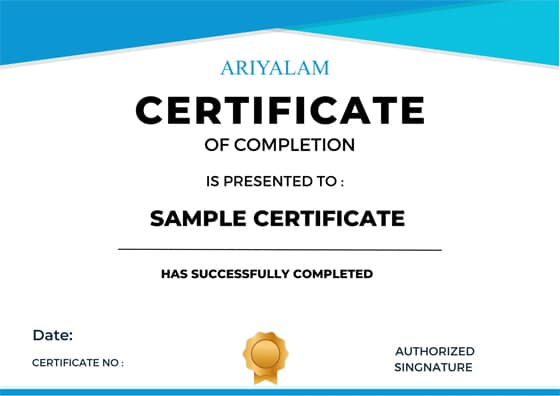Artificial Intelligence Online Course
Our Artificial Intelligence online course provides a comprehensive introduction to the world of AI, equipping students with the skills needed to design and implement intelligent systems. Covering essential concepts like machine learning, deep learning, natural language processing, and neural networks, the course offers both theoretical understanding and hands-on experience. Our expert instructors guide learners through real-world applications, fostering problem-solving abilities and creativity. Whether you’re a beginner or a tech enthusiast, this course empowers you to harness AI’s transformative potential and advance your career.

AI Course Fees
Key Features
AI Certification

Key Features
AI Certification

Artificial Intelligence Course Prerequisites:
Artificial Intelligence online courses typically require a strong foundation in mathematics, including calculus, linear algebra, probability, and statistics. Programming experience, particularly in languages like Python, is essential, as well as familiarity with data structures and algorithms. Knowledge of computer science fundamentals, such as software development and system design, is beneficial. Basic understanding of machine learning concepts and experience with data analysis tools can also provide a strong starting point for AI coursework.
Artificial Intelligence Course Syllabus
Module 1: Introduction to Data Science
- What is Data Science?
- Introduction to Machine Learning, Deep Learning, and AI
- Overview of Data Analytics and its types (Descriptive, Predictive, Prescriptive)
Module 2: Introduction to Python
- What is Python and why is it used?
- How to install Python
- Introduction to Python IDEs (Integrated Development Environments)
- Overview of Jupyter Notebook
Module 3: Python Basics
- Understanding basic data types
- Working with lists and slicing data
- Using IF statements and loops
- Creating and managing dictionaries and tuples
- Writing functions
- Working with arrays
- Selecting data by position and labels
Module 4: Python Packages
- Introduction to key libraries:
- Pandas for data manipulation
- NumPy for numerical computations
- Scikit-Learn for machine learning
- Matplotlib for data visualization
Module 5: Importing Data
- How to read data from CSV files
- Saving data in Python
- Loading and managing Python data objects
- Writing data back to CSV files
Module 6: Manipulating Data
- Selecting rows and columns
- Rounding numbers
- Merging datasets
- Aggregating data
- Common data cleaning and transformation techniques
Module 7: Statistics Basics
- Measures of central tendency: Mean, Median, Mode
- Understanding skewness and normal distribution
- Basics of probability:
- Definitions and types
- Odds ratio
- Variance and standard deviation
- Bias-variance trade-off
- Underfitting vs. overfitting
- Distance metrics:
- Euclidean Distance
- Manhattan Distance
- Outlier detection and analysis:
- Interquartile range (IQR)
- Box plots and scatter plots
- Cook’s distance
- Handling missing values:
- What is NA (Not Available)?
- Central imputation and KNN imputation
- Correlation analysis:
- Pearson correlation
- Positive and negative correlations
Module 8: Error Metrics
- Classification Metrics:
- Confusion matrix
- Precision, Recall, and F1 Score
- Specificity
- Regression Metrics:
- Mean Squared Error (MSE)
- Root Mean Squared Error (RMSE)
- Mean Absolute Percentage Error (MAPE)
Module 9: Machine Learning
- Supervised Learning
- Linear Regression:
- Understanding linear equations, slope, intercept, R-squared
- Logistic Regression:
- Odds ratio, probability of success/failure, ROC curve
- Bias-Variance trade-off
- Unsupervised Learning
- K-Means Clustering
- K-Means++
- Hierarchical Clustering
- Support Vector Machines (SVM)
- Concepts of support vectors and hyperplanes
- Linear hyperplanes and SVM kernels
- SVM Kernels
- Linear, Radial, and Polynomial kernels
- Other Machine Learning Algorithms
- K-Nearest Neighbors (KNN)
- Naïve Bayes Classifier
- Decision Trees (CART and C5.0)
- Random Forests
Module 10: Artificial Intelligence
- Introduction to AI concepts
- Understanding perceptrons and multi-layer perceptrons
- Markov Decision Processes
- Logical agents and first-order logic
- Applications of AI in real-world scenarios
Module 11: Deep Learning Algorithms
- Convolutional Neural Networks (CNN)
- Recurrent Neural Networks (RNN)
- Artificial Neural Networks (ANN)
Introduction to Natural Language Processing (NLP)
- Text pre-processing techniques:
- Noise removal
- Lexicon normalization (Lemmatization and Stemming)
- Object standardization
Text to Features (Feature Engineering)
- Syntactical parsing
- Dependency grammar
- Part of Speech (POS) tagging
- Entity parsing and named entity recognition (NER)
- Topic modeling
- N-grams and TF-IDF
- Word embeddings and feature extraction
Tasks of NLP
- Text classification
- Text matching:
- Levenshtein distance
- Phonetic and flexible string matching
FAQ
1. What is Artificial Intelligence (AI) and why should I learn it?
2. What topics are typically covered in an Artificial intelligence online course?
Courses cover machine learning, neural networks, natural language processing, computer vision, deep learning, data analysis, and AI ethics. You’ll gain skills to build intelligent algorithms and models.
3. Do I need programming knowledge to enroll in an AI course?
4. What career opportunities are available after completing an AI course?
5. How long does it take to complete an Artificial Intelligence online course?
Course length varies. Some take a few weeks, focusing on basics, while others last several months or years, covering advanced topics, hands-on projects, and industry applications comprehensively.
6. What top companies have Jobs in AI?
Enquiry Now
